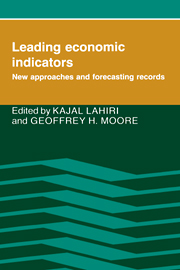Book contents
- Frontmatter
- Contents
- Preface
- List of contributors
- 1 Introduction
- PART I NEW CONCEPTS AND METHODS
- PART II FORECASTING RECORDS AND METHODS OF EVALUATION
- PART III NEW ECONOMIC INDICATORS
- 17 Commodity prices as a leading indicator of inflation
- 18 A leading indicator of inflation based on interest rates
- 19 Using composite leading indicators of consumption to forecast sales and to signal turning points in the stock market
- 20 Economic indicators for Australia's service sector
- 21 Purchasing management survey data: Their value as leading indicators
- 22 An agenda for inventories input to the leading composite index
- Index
18 - A leading indicator of inflation based on interest rates
Published online by Cambridge University Press: 05 June 2012
- Frontmatter
- Contents
- Preface
- List of contributors
- 1 Introduction
- PART I NEW CONCEPTS AND METHODS
- PART II FORECASTING RECORDS AND METHODS OF EVALUATION
- PART III NEW ECONOMIC INDICATORS
- 17 Commodity prices as a leading indicator of inflation
- 18 A leading indicator of inflation based on interest rates
- 19 Using composite leading indicators of consumption to forecast sales and to signal turning points in the stock market
- 20 Economic indicators for Australia's service sector
- 21 Purchasing management survey data: Their value as leading indicators
- 22 An agenda for inventories input to the leading composite index
- Index
Summary
Correct prediction of the inflation rate and its turning points is an important problem for businesses and households alike. An early signal for a major turn in the inflation rate will allow economic agents to redo their economic calculations for the forthcoming environment. Because inflation rates are highly cyclical, Moore (1983a, 1983b) adapted the leading indicator approach, long associated with the National Bureau of Economic Research (NBER) studies of business cycles, to specifically forecast the inflation rate. Klein (1986) successfully extended this methodology of inflation forecasting to a number of major market-oriented economies. Moore (1986) reported that the composite inflation indicator has a better ex post record in forecasting next year's inflation rate than the consensus of economists has achieved. In Chapter 16, Roth evaluated five different leading indicators of inflation and found that composite indicators have a very impressive track record.
The main purpose of this chapter is to propose another predictor of inflation obtained by extracting information about future inflation from nominal interest rates of various maturities. For the sake of comparison, we will analyze these forecasts in the context of the existing leading indicator literature. Since the nominal interest rate, which is known at the beginning of a period, can be written as expected real interest rate plus expected rate of inflation, a reasonable estimate of the ex ante real rate will yield an equally reasonable estimate of the inflation component.
- Type
- Chapter
- Information
- Leading Economic IndicatorsNew Approaches and Forecasting Records, pp. 339 - 354Publisher: Cambridge University PressPrint publication year: 1991
- 3
- Cited by



